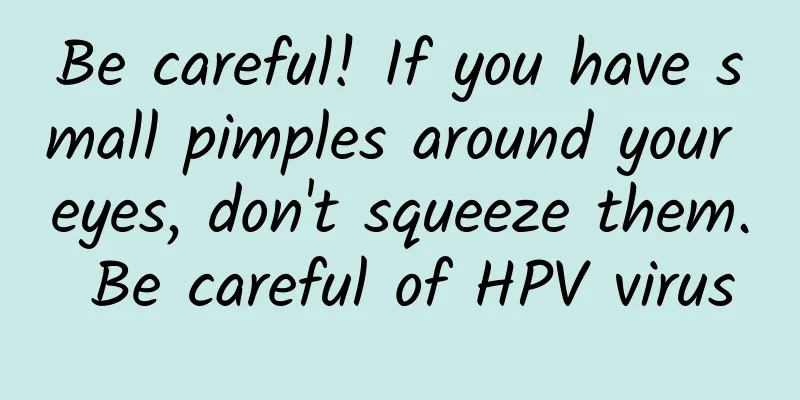Be careful! If you have small pimples around your eyes, don't squeeze them. Be careful of HPV virus

|
The skin around the eyes is the thinnest and most sensitive part of the human body. In addition to wrinkles, many people also experience small pimples: some may not hurt or itch, while others may be accompanied by redness and swelling; some will automatically shrink and disappear, while others will grow more and more, over and over again... So what are these little bumps? Let’s analyze them for you today. Fat particles appear around the eyes, is it all caused by eye cream? Some small white bumps the size of rice grains or sesame seeds grow around the eyes. If you prick them with a needle, white sebum-like substances may be discharged. These are often called "fat granules." Many people think that the growth of "fat particles" is caused by excessive nutrition in eye cream, poor skin absorption, or eye cream blocking the hair follicles. In fact, this is not the case. "Fat particles" are actually called milia in medicine . They are essentially small cysts , the contents of which are mainly some keratin , and there is no so-called fat . 1. Two major causes of milia around the eyes Milia can be classified as either spontaneous or secondary , but in either case, the mechanism of its occurrence is unclear. Spontaneous ones may be related to factors such as genetics and sun exposure ; secondary ones are mainly related to skin irritation, such as after skin laser treatment, trauma, or the use of irritating ointments or cosmetics. In general, there is no direct relationship between topical skin care products and chestnut papules . 2. Don’t squeeze milia. It’s safer this way. Many people can't help but squeeze out the white substance when they see it, thinking that squeezing it out will help it heal faster. But it is not recommended to do it yourself. First of all, you may not be able to squeeze it out by yourself, because milia have a certain depth . Shallow ones are easier to squeeze out, but deeper ones are difficult to squeeze out. In addition, improper operation will cause inflammation and infection. Therefore, it is recommended that you go to a professional dermatology clinic for diagnosis and treatment . The doctor will choose needle picking or laser treatment based on the actual situation. Will you get stye if you look at something you shouldn’t? There is a saying that if you look at something you shouldn't look at, your eyes will get stye. Although it is just a joke, if you really get stye, you will be the one who suffers. Stye, also known as sty , is a very common eye disease. Its most typical symptom is the growth of a red lump at the base of the eyelashes , just like a mosquito bite. 1. If you have a stye, don’t squeeze it with your hands Once you get a stye, you should apply hot compress under the guidance of a doctor, and use antibiotic eye drops and eye ointments; if pus appears on the eyelid margin or skin, do not squeeze it with your hands to avoid spreading the inflammation. You should go to the hospital in time for incision and drainage of the pus for treatment. 2. Four reasons for stye ① Rubbing your eyes with dirty hands will cause bacteria to enter through the opening of the glands. ② Overwork of the eyes causes the orbicularis oculi muscles around the eyes to contract, resulting in blockage of the gland opening. ③ If you have eye diseases such as myopia, hyperopia, astigmatism, etc., and often squint to see things , it will contract the orbicularis oculi muscle around the eye, block the gland outlet, and affect its secretory function. ④ Eating too much oily food and high-sugar food will increase the oil secretion of the glands at the edge of the eyelids. Coupled with insufficient cleaning, the gland outlet is prone to blockage. Suggestion: In addition to avoiding those inducements , people who are prone to styes can supplement more vitamin A , such as purslane, cabbage, shepherd's purse, tomato, eggplant and other foods. Vitamin A is an important nutrient for maintaining the health of the skin and mucous membranes . Lack of it will cause the eyelids to lose resistance and become more susceptible to bacterial invasion. There are many types of syringoma, but the risk is relatively low Although it has the word "tumor" in its name, syringoma is not a big threat and is a benign skin tumor . It is caused by the blockage of small sweat glands on the skin, which hinders the fat metabolism function, leading to fat hyperplasia in the skin epidermis and forming papule-like particles. Symptoms: Generally, they are flat papules ranging in size from millet to mung bean ; they are densely distributed, and their color is close to the skin color, and may also be red or brown ; they feel soft to the touch, and have no particles inside. They will not disappear automatically, nor will they become malignant. 1. Classification of Syringoma ① Dense syringoma : This type of syringoma generally only grows around the eyes or in a certain part. As the disease progresses, the syringoma becomes more and more dense, and finally may fuse into a mass. ② Eruptive syringoma : This type of syringoma grows in more than one location, and is symmetrically distributed on the neck, chest, armpits, upper arms, and around the navel. There are a large number of them, and the lesions are glossy light rose in color. ③ Clear cell syringoma : This type of syringoma is often associated with diabetes. ④Other subcategories : There are also some localized syringomas, including trichoepithelioma, genital syringoma, acral syringoma, etc. 2. Predisposing factors of syringoma The cause of syringoma has not been clearly studied yet. Experts speculate that it is mainly related to the following factors: ① Genetic factors : If parents or other immediate relatives have the disease, the chances of their offspring getting the disease will be greater than that of the general population. ② Endocrine factors : Investigations have shown that during menstruation or pregnancy, women’s estrogen levels increase, which causes endocrine disorders, affecting normal metabolism and thus inducing syringoma. ③Environmental factors : Some chemical substances in the air, such as exhaust gas, can also cause hormone imbalance and endocrine disorders after entering the human body through various channels, thus increasing the risk of syringoma. 3. Treatment of syringoma Generally, CO2 laser is used to vaporize the lesions. After treatment, the wound is kept dry and antibiotic ointment is applied . As syringoma increases year by year, some patients cannot completely eliminate the lesions after one treatment and need regular review and treatment. Flat warts and filiform warts are related to HPV virus and can be contagious. If there are flesh-colored, pink, round, smooth bumps around the eyes; the number is relatively large and dense; there is an itchy sensation, and the lesions may be arranged in a beaded pattern after scratching; and over time, the color will turn dark brown, then it may be flat warts . If it appears as a small thorn-like, pointed protrusion with a pedicle, like an enoki mushroom or an inverted nail; and it causes slight pain when accidentally touched, then it may be a filiform wart . 1. Does having flat warts or filiform warts mean you have cervical cancer? Although the manifestations are different, both flat warts and filiform warts are caused by HPV virus infection - flat warts are commonly caused by HPV types 3 and 5; filiform warts are generally caused by HPV types 1, 2, 4, 27 and 29. Many people may think that cervical cancer is also related to HPV infection, so if you have flat warts or filiform warts, are you not far from cervical cancer? Actually, not really. First, there are about 200 subtypes of HPV virus, and the viruses that cause flat warts and filiform warts are low-risk and will not induce cancer ; secondly, medium- and high-risk HPV viruses also require continuous infection to induce cervical cancer. 2. Flat warts and filiform warts are not carcinogenic, but they are contagious. HPV virus is the smallest spherical DNA virus known to date, so much so that in front of it, human skin is like a "sieve" with holes everywhere, allowing it to easily enter. After surviving in epithelial cells , as the cells gradually age and fall off, the HPV virus will also fly around with the shed skin flakes . If it comes into contact with healthy people, there is a chance of causing infection , especially those with wounds on the skin . In addition to transmission between partners and mothers and babies , ordinary people may also be infected through skin contact such as hugging and shaking hands with infected people , or by using their daily necessities or clothing . 3. To prevent and control "warts", do 4 things ① Get vaccinated as soon as possible : Low-risk HPV that causes "warts" is not a big problem, but if you continue to be infected with medium- and high-risk HPV, it will increase the risk of cancer. Therefore, it is very important to get vaccinated with HPV vaccine as soon as possible. The protection of HPV vaccine can reach more than 90%, and the earlier the better. For people who have already had sex, the protection is reduced, but it can still reach 60~70%. ② Do not share personal belongings : HPV virus can be transmitted through indirect contact, so it is best not to share personal belongings. ③ Pay attention to sexual hygiene : HPV virus can be transmitted through sex, so it is recommended to avoid early sexual intercourse (under 18 years old), avoid having sex during menstruation and postpartum period, and avoid multiple sexual partners. ④ Improve your own immunity : People with strong immunity are less likely to suffer damage to their health even if they are infected with low-risk HPV, while people with weak immunity will give the virus an opportunity to take advantage. A balanced diet, regular exercise and adequate sleep are the simplest ways to improve immunity. I hope everyone can implement them well. It is also important to note that when you have warts, you must not pick them with your hands. On the one hand, picking with your hands can only remove the raised parts on the surface, and the root lesions cannot be completely removed, and they are likely to grow again. On the other hand, picking may cause the virus in the wart to spread through skin contact and infect other parts of the body. It is better to seek medical treatment in time for professional treatment. Xanthomas may be a sign of high blood lipids If there are yellowish soft bumps on the upper and lower eyelids and no pain, it is most likely a xanthoma . In addition, it can also appear on the elbows, thighs, heels , etc. At present, it is generally believed that this is due to lipid metabolism disorders in the body , and excessive fat in the blood is deposited in the eyelid skin . It can occur in patients with hereditary hyperlipidemia, diabetes and other secondary hyperlipidemia. Many people who have this type of xanthomas go to the dermatology department, thinking that surgery can cure them. However, it actually has an impact on the cardiovascular and cerebrovascular systems and needs early treatment . Do not wait until the condition becomes serious and damage to the heart and brain occurs before considering controlling blood lipids. In addition to paying attention to diet and exercising more to help control blood lipids. Source: China Women's News |
Recommend
Toothache is really a disease! Not only does it hurt, it can also cause these physical diseases——
Review expert: Wang Xuejiang, professor at Capita...
Can I eat mangosteen when I have my period?
Jackfruit is a relatively popular fruit with a sw...
What's the matter with the strong echo of 1209 shown on B-ultrasound after medical abortion?
After medical abortion, if B-ultrasound shows str...
How is a colposcopy performed?
In clinical practice, colposcopy is of great valu...
What should I do if the baby hasn't fallen out after 7 hours of medical abortion?
Medical abortion is a common procedure for termin...
What are the reactions to taking medicine for abortion?
Taking medicine to induce abortion is also a comm...
Can I use alcohol on my nipples?
After giving birth, women will choose breastfeedi...
Two or three things about reflux
Gastroesophageal reflux is a common digestive sys...
Can low estrogen levels cause amenorrhea in women?
What women are most worried about after they reac...
Business Insider: Research shows that the average Facebook user spends 7 times more time browsing than Twitter
People often talk about the number of users of so...
What to do with breast pimples? The correct way is this
Women's breasts may have lumps, which are med...
Women who eat too little will have many problems
In order to maintain a slim figure, modern women ...
How can young professionals order food to eat well? Nutritionists teach you some tips!
Getting up in a hurry and setting off in a panic,...
There are small pieces of meat in the vagina
I believe that every woman should attach great im...
Alcohol and drugs a deadly combination
During festivals, it is inevitable that friends a...









